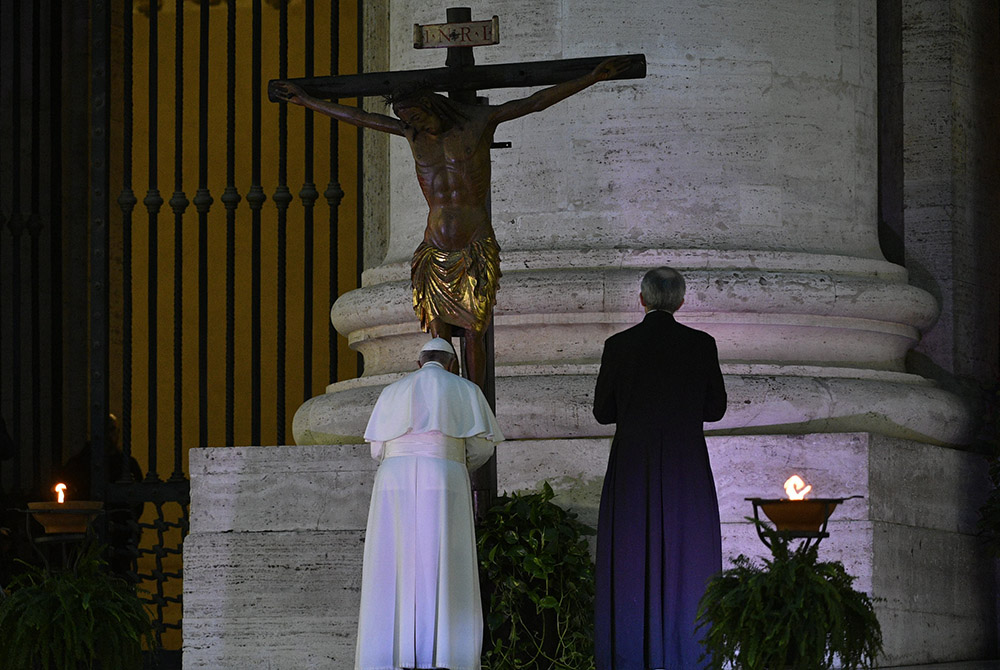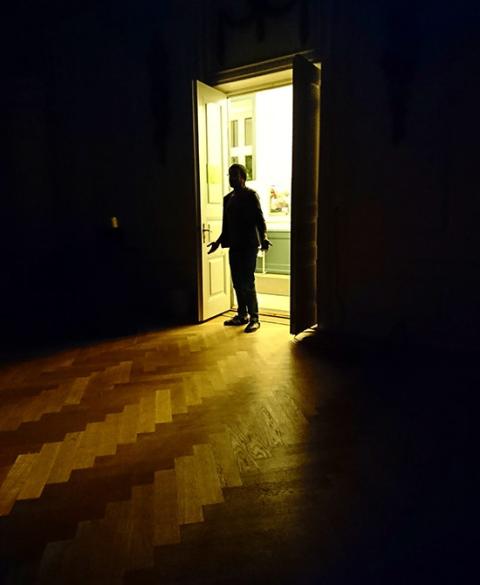
Pope Francis prays before the crucifix from the Church of St. Marcellus in Rome during a prayer service in an empty St. Peter's Square at the Vatican March 27. The crucifix was carried in Rome in 1522 during the "Great Plague." At the conclusion of the service the pope held the Eucharist as he gave an extraordinary blessing "urbi et orbi" (to the city and the world). (CNS/Vatican Media)
A little over 40 days ago, I reflected on these pages about the signs and symbols of our faith lived out during the Lenten season. "The refrain of 'repent and believe in the Good News' rang in my ears." I wrote on the Friday after Ash Wednesday, "That is the good news of Lent, each step is another opportunity to be marked by the cross, to receive the grace of God not in vain but in the glory of the moment." Little could I have known then the opportunities that this Lenten season would present to be marked by the cross.
Like many, I've marveled these past weeks as news has developed, as life has radically changed, as businesses shut their doors and as ministry became a delicate balance between the call of charity and the demands of safety. With mortality and diagnosis figures from COVID-19 still on the rise, each day is marked by a surreal feeling — what many have termed the new normal and what is astonishing in its unbridled mix of mystery and anxiety.
In the midst of all of this, we, as a people of faith, have made our annual pilgrimage to the cross. This year's journey was quite different than others. Death was more palpable; despair more available; isolation more regular.
In these circumstances, the Passion takes on new meaning. Just as I now cringe as I notice the distance (or lack thereof) between people in everyday life, on television and in movies, I immerse myself in the way of the cross in a new way. The isolation and abandonment Christ experienced takes on new shades in a world where people admitted to hospitals are prohibited from having visitors and those living in nursing homes and on their own are confined by mandatory lockdowns, let alone the many who are dutifully obeying stay at home orders. In these situations, the isolation of the cross becomes more real, contrasted with the sacrifice made by those whose jobs and livelihoods won't allow them to enter such isolation.
The stress and trauma of this moment in our history is difficult. For most people, it is unlike anything they've ever experienced before. The uncertainty of each moment and the unknown sense of what is to come or when/ how it will all be resolved is draining. The weight of the world, it would seem, is on our minds and hearts. In this climate, we come to see that our daily living, the reality of our current situation is a cross.

(Unsplash/Amoon Ra)
We don't get to pick our crosses. If we could, we would certainly endure them differently. Rather, the crosses we bear, both individually and communally, stem from the deepest recesses of our being. They press on our deepest wounds and needs, highlighting our individual and communal blind spots and shortcomings.
As we weather this extraordinary season of life, the crosses that present themselves call forth in us resilience in the face of adversity. These crosses cannot simply be endured as burdens but invite us to encounter them as experiences to be in union with God, most especially with Christ and his cross.
Like Jesus, we walk this way stripped of control. Our only choice, it would seem at this moment, is how we will experience it all. The unexpected nature of our current reality and the mysterious way we travel (and will continue to travel for the foreseeable future) are the crosses we bear. As we encounter the many emotions of these days — from loneliness and isolation to gratitude and awe — we must ask ourselves: Can we offer these to God? Not so they might be taken away but so that we might share these emotions (and moments of light and darkness they bring) with God, trusting that Christ is here with us.
This question is one of connection in the cross, connection in and through Christ crucified, resurrected, and alive among us, even now. In the words of Caryll Houselander, the "realization of our oneness in Christ is the only cure for human loneliness." Together, we will weather this pandemic and the many tides of emotions and realizations it brings. As we experience the absence of traditions this Holy Week and scarcity of formal sacraments for weeks to come, we can hope to be in union with people the world over for whom this absence is not a new reality. Without minimizing our own struggle we can embrace and be with others, strengthened in walking together, and lighter for having held each other's crosses.
The image etched in my mind as I consider all this is a solitary figure moving slowly, not without labor, across an abandoned, rain-soaked St. Peter's Square. There, in falling darkness, Pope Francis offered his extraordinary Urbi et Orbi blessing March 27. Behind him as he spoke, the miraculous crucifix from the Church of San Marcello. Watching the blessing live, I marveled at the scene before me, my eyes transfixed by the body on the cross, strewn not just with painted wounds but with streams of water dripping from its body as if like tears from the whole world.
As I absorbed the image, I thought of people throughout the world watching the scene simultaneously. In that moment, the universal body of Christ felt real and united in the cross that drew us together. The shining screens that for weeks have delivered us the hard news of the virus drew us in and from our isolation into communion with one another. Together we joined in prayer and were reminded that together we bear the cross of our current reality with grace and mercy.
On this Good Friday of our lives, in a space that feels much more like Holy Saturday than Easter Sunday, the lesson is simple: We are not alone.
Now more than ever, we may be separated and feeling the effects of isolation but we are not alone. Jesus has walked this way and we walk with him now. We are united by our faith in a God who can hold it all and are urged to remember that the glory of the cross is in our union with the One who is with is in such suffering. With Jesus we are united, never alone, to the glory of the One who made us and walks with us no matter the circumstances. Together we embrace the cross today and always, knowing that through it we are led to new life and the Easter joy that, in time, surely awaits us.
[A Sister of St. Joseph of Philadelphia, Colleen Gibson is the author of the blog Wandering in Wonder and has been published work in various periodicals including America, Commonweal and Give Us This Day. She currently serves as coordinator of services at the SSJ Neighborhood Center in Camden, New Jersey.]
Advertisement







